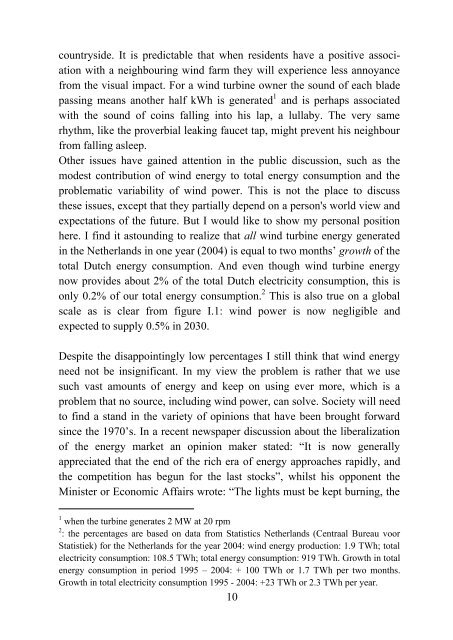The sounds of high winds
The sounds of high winds
The sounds of high winds
You also want an ePaper? Increase the reach of your titles
YUMPU automatically turns print PDFs into web optimized ePapers that Google loves.
countryside. It is predictable that when residents have a positive association<br />
with a neighbouring wind farm they will experience less annoyance<br />
from the visual impact. For a wind turbine owner the sound <strong>of</strong> each blade<br />
passing means another half kWh is generated 1 and is perhaps associated<br />
with the sound <strong>of</strong> coins falling into his lap, a lullaby. <strong>The</strong> very same<br />
rhythm, like the proverbial leaking faucet tap, might prevent his neighbour<br />
from falling asleep.<br />
Other issues have gained attention in the public discussion, such as the<br />
modest contribution <strong>of</strong> wind energy to total energy consumption and the<br />
problematic variability <strong>of</strong> wind power. This is not the place to discuss<br />
these issues, except that they partially depend on a person's world view and<br />
expectations <strong>of</strong> the future. But I would like to show my personal position<br />
here. I find it astounding to realize that all wind turbine energy generated<br />
in the Netherlands in one year (2004) is equal to two months’ growth <strong>of</strong> the<br />
total Dutch energy consumption. And even though wind turbine energy<br />
now provides about 2% <strong>of</strong> the total Dutch electricity consumption, this is<br />
only 0.2% <strong>of</strong> our total energy consumption. 2 This is also true on a global<br />
scale as is clear from figure I.1: wind power is now negligible and<br />
expected to supply 0.5% in 2030.<br />
Despite the disappointingly low percentages I still think that wind energy<br />
need not be insignificant. In my view the problem is rather that we use<br />
such vast amounts <strong>of</strong> energy and keep on using ever more, which is a<br />
problem that no source, including wind power, can solve. Society will need<br />
to find a stand in the variety <strong>of</strong> opinions that have been brought forward<br />
since the 1970’s. In a recent newspaper discussion about the liberalization<br />
<strong>of</strong> the energy market an opinion maker stated: “It is now generally<br />
appreciated that the end <strong>of</strong> the rich era <strong>of</strong> energy approaches rapidly, and<br />
the competition has begun for the last stocks”, whilst his opponent the<br />
Minister or Economic Affairs wrote: “<strong>The</strong> lights must be kept burning, the<br />
1 when the turbine generates 2 MW at 20 rpm<br />
2 : the percentages are based on data from Statistics Netherlands (Centraal Bureau voor<br />
Statistiek) for the Netherlands for the year 2004: wind energy production: 1.9 TWh; total<br />
electricity consumption: 108.5 TWh; total energy consumption: 919 TWh. Growth in total<br />
energy consumption in period 1995 – 2004: + 100 TWh or 1.7 TWh per two months.<br />
Growth in total electricity consumption 1995 - 2004: +23 TWh or 2.3 TWh per year.<br />
10
















